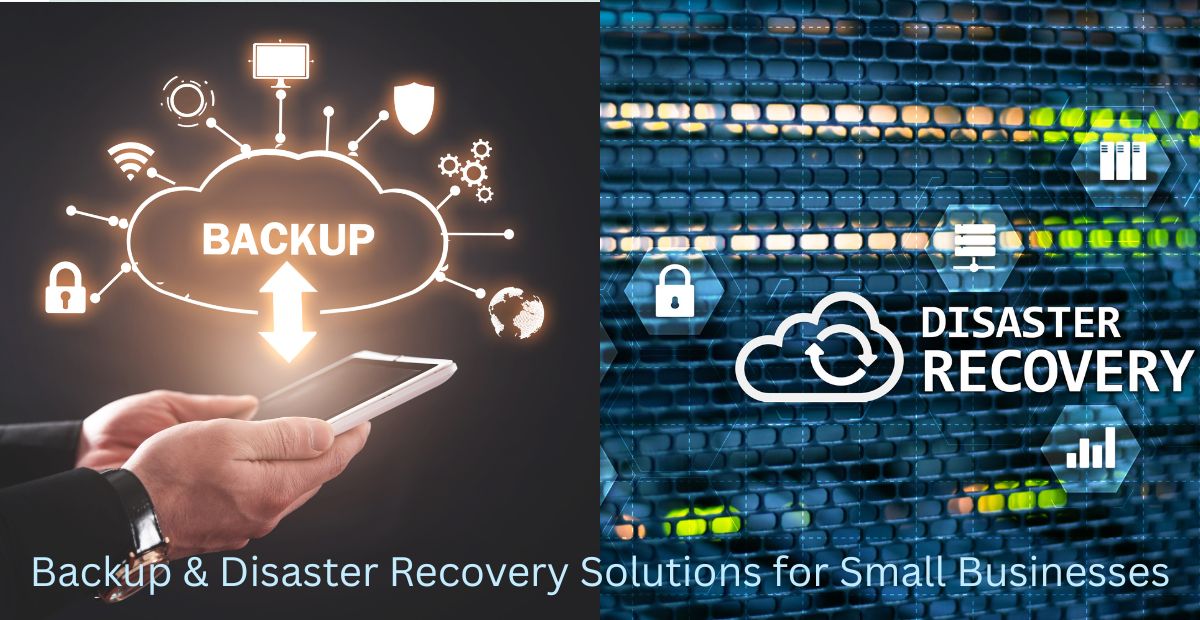Introduction
In today’s digital first world, data is the lifeblood of any business. For small businesses, losing critical data whether due to cyberattacks, hardware failures, or natural disasters can be devastating. According to FEMA, 40% of small businesses never reopen after a disaster, and those that do often struggle to recover fully.
This is where Backup & Disaster Recovery (BDR) solutions come into play. A well-structured BDR strategy ensures that your business can quickly restore operations with minimal downtime, protecting your revenue, reputation, and customer trust.
In this blog, we’ll explore:
- The importance of BDR for small businesses
- Different types of backup solutions
- Disaster recovery best practices
- Top BDR tools for SMBs
- Implementation strategies
- Cost considerations
- Future trends
By the end, you’ll have a clear roadmap to safeguard your business against data loss and disasters.
Why Backup & Disaster Recovery is Crucial for Small Businesses
Small businesses often assume they’re too small to be targeted by cybercriminals or that data loss won’t affect them. However, the reality is starkly different:
- 60% of small businesses shut down within six months of a cyberattack (National Cyber Security Alliance).
- Human error causes 95% of cybersecurity breaches (IBM).
- Ransomware attacks cost businesses $4.54 million on average per incident (Statista).
Key Benefits of BDR for Small Businesses:
- Minimizes Downtime – Quick recovery ensures business continuity.
- Protects Against Cyber Threats – Ransomware and malware can be mitigated.
- Compliance & Legal Protection – Meets GDPR, HIPAA, and other regulations.
- Cost Savings – Prevents expensive data recovery efforts.
- Customer Trust – Ensures data integrity and service reliability.
Without a BDR plan, your business is at risk of permanent closure.
Common Causes of Data Loss for Small Businesses
Understanding the threats helps in designing an effective BDR strategy. The most common causes include:
1. Cyberattacks (Ransomware, Phishing, Malware)
Cyberattacks like ransomware, phishing, and malware can cripple your business, leading to data loss, financial damage, and operational downtime. A robust Backup & Disaster Recovery (BDR) plan ensures your critical data remains secure and quickly recoverable, even after a cyber incident.
- Cybercriminals increasingly target SMBs due to weaker security measures.
2. Hardware Failures
Hardware failures such as server crashes, storage malfunctions, or power outages can disrupt operations and lead to irreversible data loss. A strong Backup & Disaster Recovery (BDR) strategy ensures your business stays resilient by maintaining secure, up-to-date backups and enabling rapid system restoration.
- Storage devices, servers, and hard drives can all malfunction without warning.
3. Human Error
Even the most careful employees can accidentally delete critical files, overwrite important data, or misconfigure systems putting your business at risk. A robust Backup & Disaster Recovery (BDR) plan acts as a safety net, allowing you to quickly restore lost or corrupted data with minimal disruption.
- Accidental deletions, misconfigurations, or improper handling of data.
4. Natural Disasters
Floods, earthquakes, hurricanes, and other natural disasters can devastate your physical infrastructure and wipe out critical data in an instant. A comprehensive Backup & Disaster Recovery (BDR) plan guarantees your business remains operational, even when disaster strikes.
- Floods, fires, earthquakes, and power outages can destroy physical infrastructure.
5. Software Corruption
Software corruption from failed updates, system crashes, or buggy patches—can cripple your operations and lead to costly downtime. A proactive Backup & Disaster Recovery (BDR) plan ensures seamless continuity by restoring clean, uncorrupted versions of your critical systems in minutes.
- System crashes, bugs, or failed updates can corrupt critical files.
6. Theft or Insider Threats
Data breaches caused by theft, malicious insiders, or unauthorized access can devastate your business leading to financial loss, reputational damage, and legal consequences. A robust Backup & Disaster Recovery (BDR) solution acts as your last line of defense, ensuring sensitive data remains protected and recoverable, even in the event of sabotage or theft.
- Disgruntled employees or burglars can steal or sabotage data.
A multi-layered BDR approach mitigates these risks effectively.
Types of Backup Solutions
There are three primary backup methods, each with pros and cons:
A. On-Premises Backup
For businesses requiring maximum control over sensitive data, on-premises backup delivers lightning-fast recovery speeds and air-gapped security against modern cyberthreats. Unlike cloud-only solutions, local backup appliances keep your critical data within your private infrastructure
- Data is stored locally (external drives, NAS, servers).
Pros:
- Fast recovery, full control, no internet dependency.
Cons:
- Vulnerable to physical disasters, requires maintenance.
B. Cloud Backup
In today’s digital landscape, cloud backup offers businesses a flexible and reliable way to protect critical data from cyber threats, hardware failures, and disasters. With automated, encrypted backups stored in geographically dispersed data centers, your information remains accessible and secure—no matter what happens on-site.
- Data is stored remotely (AWS, Google Cloud, Backblaze).
Pros:
- Scalable, accessible anywhere, automated.
Cons:
- Slower recovery, ongoing subscription costs.
C. Hybrid Backup
Get the best of both worlds with hybrid backup combining the control of on-premises storage with the flexibility of cloud backup for unbeatable data protection. This robust solution ensures fast local recoveries while keeping an off-site cloud copy for disaster recovery, safeguarding your business against ransomware, hardware failures, and natural disasters
- Combines on-premises and cloud backups.
Pros:
- Redundant, balances speed & security.
Cons:
- More complex setup.
Best Practice:
- Follow the 3-2-1 Rule – Keep 3 copies of data, on 2 different media, with 1 offsite backup.
Disaster Recovery (DR) Strategies
- Backup alone isn’t enough—you need a disaster recovery plan to resume operations quickly.
Key DR Concepts:
- Recovery Time Objective (RTO): Max acceptable downtime (e.g., 1 hour).
- Recoverable Point Objective (RPO): Maximum amount of data that can be lost (e.g., last 24 hours).
DR Strategies:
- Failover Systems – Automatic switch to backup servers.
- Disaster Recovery as a Service (DRaaS) – Cloud-based DR solutions.
- Virtual Machine (VM) Replication – Instant recovery via virtualized environments.
How to Implement a BDR Plan
Step 1: Assess Risks & Critical Data
- Identify what needs protection (financial records, customer data, apps).
Step 2: Choose Backup & DR Solutions
- Select based on RTO, RPO, and budget.
Step 3: Automate Backups
- Schedule daily/weekly backups to prevent human error.
Step 4: Test Recovery Regularly
- Simulate disasters to ensure quick restoration.
Step 5: Train Employees
- Educate staff on cybersecurity and recovery protocols.
Step 6: Review & Update
- Adjust the plan as your business grows.
Cost Considerations for BDR Solutions
- Cloud Backup: $5–$50/month per device.
- On-Premises Backup: $500–$5,000 (hardware + setup).
- DRaaS: $200–$2,000/month (enterprise-grade).
Tip:
- The cost of not having BDR (downtime, fines, reputational damage) far outweighs the investment.
Common Mistakes to Avoid
- Assuming “Cloud Backup is Enough” – Always follow the 3-2-1 rule.
- Not Testing Backups – Untested backups often fail when needed.
- Ignoring Employee Training – Human error is the biggest risk.
- Delaying Updates – Outdated software is vulnerable to attacks.
Future Trends in Backup & Disaster Recovery
- AI & Machine Learning – Predictive threat detection.
- Zero-Trust Security Models – Enhanced ransomware protection.
- Edge Computing Backups – Faster local recovery.
- Blockchain for Data Integrity – Tamper-proof backups.
Conclusion
A robust Backup & Disaster Recovery (BDR) strategy is non-negotiable for small businesses. Whether it’s ransomware, hardware failure, or natural disasters, being prepared ensures business continuity, compliance, and customer trust.
FAQs: Backup & Disaster Recovery Solutions for Small Businesses
What is Backup & Disaster Recovery (BDR)?
Why do small businesses need BDR solutions?
- 0% of SMBs close within 6 months of a cyberattack.
- Data loss can lead to financial, legal, and reputational damage.
- A BDR strategy ensures business continuity and regulatory compliance.
What’s the difference between backup and disaster recovery?
- Backup = Copying and storing data securely.
- Disaster Recovery (DR) = A structured plan to restore systems after a disaster.
- Example: Backups save your files, while DR ensures your servers and apps come back online quickly.
A best practice for data protection:
What is the 3-2-1 backup rule?
- Three copies of your data (two backups and the primary copy).
- two distinct forms of storage (e.g., external drive + cloud).
- 1 offsite backup (to protect against physical disasters).
How often should a small business back up data?
- Daily backups for critical data (e.g., financial records, customer info).
- Weekly backups for less critical files.
- Real-time backups for highly sensitive operations (e.g., databases).
What is Disaster Recovery as a Service (DRaaS)?
- No need for in-house IT expertise.
- Fast recovery (minutes instead of hours).
- Scalable for growing businesses.
How much does a BDR solution cost for a small business?
- Cloud Backup: $5–$50/month per device.
- On-Premises Backup: $500–$5,000 (hardware + setup).
- DRaaS: $200–$2,000/month (enterprise-grade).
- Tip: The cost of not having BDR (downtime, fines, lost customers) is far higher.
How can I protect my business from ransomware?
- Use air-gapped backups (offline copies).
- Enable AI-based threat detection (e.g., Acronis, Veeam).
- Train employees on phishing awareness.
- Follow the 3-2-1 backup rule.
What’s the fastest way to recover after a disaster?
- Virtual Machine (VM) Replication – Spin up backups instantly in the cloud.
- Failover Systems – Automatically switch to backup servers.
- DRaaS: Let a provider take care of your recovery.
How do I test if my backups work?
- Restore sample files periodically.
- Simulate a disaster (e.g., mock ransomware attack).
- Check Recovery Time Objective (RTO) – Ensure systems come back within acceptable time.
What are common BDR mistakes small businesses make?
- Not testing backups (40% fail when needed).
- Storing all backups in one place (violates 3-2-1 rule).
- Ignoring employee training (human error causes 95% of breaches).
Is BDR necessary if I use Microsoft 365 or Google Workspace?
- Accidental deletions (files can be permanently lost).
- Ransomware attacks (sync can spread malware).
- Compliance requirements (HIPAA, GDPR).
- Solution: Use a third-party cloud backup (e.g., Veeam, Druva).
What’s the future of BDR for small businesses?
- AI-powered backups (predictive threat blocking).
- Zero-Trust Security (strict access controls).
- Blockchain backups (tamper-proof data storage).
Where can I get a BDR solution for my small business?
- Acronis Cyber Protect (Best for ransomware protection).
- Veeam Backup (Best for virtualized environments).
- Datto SIRIS (Best hybrid DR solution).
- Backblaze B2 (Low-cost cloud storage).
A robust backup and disaster recovery plan ensures your business stays resilient against data loss, downtime, and unexpected disruptions—turning potential chaos into seamless continuity. For expert guidance on securing your critical data, explore our trusted solutions at Infinity Logic.





